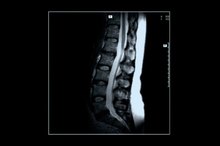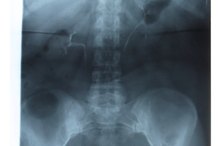Pros & Cons of Lumbar Spinal Fusion
Successful spinal fusion surgery can literally take the pain away from patients with chronic back pain caused by vertebral degeneration. A pro-and-con discussion of lumbar spinal fusion, however, should begin with considerations on the general dangers of any open-body surgery.
If you are experiencing serious medical symptoms, seek emergency treatment immediately.
These include adverse reactions to anesthesia and bleeding disorders that may threaten the heart and lungs. Infection at the site of incision and exacerbation of any serious health conditions are also possible. Learn how successful outcomes may offset failed spinal fusion risks, so you can make an informed decision about your treatment.
Pain
The best-case scenario in any spinal fusion surgery is that it will cure your pain and prevent a recurrence, if your back problem is due to degeneration rather than a traumatic event. For instance, an osteoarthritis patient may experience no more local pain when a damaged vertebra is stabilized and no longer impinges on the spinal cord nerves.
The reality is that your pain may or may not completely disappear 2. In fact, some lumbar spinal fusion patients report only a reduction in pain or recurring flare-ups. Due to the nature of vertebral degeneration, the new, post-surgical position of the joints may actually increase the pain. Spinal fusion risks include a lack of certainty about how much and what type of pain will be decreased.
- The best-case scenario in any spinal fusion surgery is that it will cure your pain and prevent a recurrence, if your back problem is due to degeneration rather than a traumatic event.
Hardware
Complications With an L5-S1 Spinal Fusion
Learn More
Before the advent of surgical hardware, the rate of successful lumbar spinal fusion was much lower that it is now. Implementing plastic and titanium intervertebral devices, plates and screws greatly increases stability after spinal fusion surgery, so that grafts can fuse more quickly and fully. A successful procedure will result in a healthy substitute for worn spinal discs and weakened vertebrae.
In some circumstances, though, this high-tech hardware can fail or migrate following surgery. Broken or shifted plates or devices that contact the spine or blood vessels can cause impairment or a medical emergency. If these spinal fusion risks become a reality, they will likely necessitate a second surgery.
- Before the advent of surgical hardware, the rate of successful lumbar spinal fusion was much lower that it is now.
- In some circumstances, though, this high-tech hardware can fail or migrate following surgery.
Complications
The success rate for lumbar spinal fusion ranges from 65 percent to over 90 percent, depending upon the procedure and your health condition. If you have a “simple” spinal fusion surgery involving two vertebrae and you are otherwise healthy, your chances are good. Your joints can fuse quickly, and you may be back in full activity within about three months.
More extensive damage, difficult placement or a weakened physical state may cause the bone fusion to fail. Other spinal fusion risks include a stress increase on other vertebrae and injury to the spinal cord. The stabilized spinal segment may cause a “transitional syndrome,” weakening the adjacent segments. Spinal cord injuries can lead to neurological damage, sexual dysfunction, paralysis or death.
- The success rate for lumbar spinal fusion ranges from 65 percent to over 90 percent, depending upon the procedure and your health condition.
- Other spinal fusion risks include a stress increase on other vertebrae and injury to the spinal cord.
Related Articles
References
- University of Maryland Medical Center
- American Academy of Orthopaedic Surgeons
- Resnick, D., Choudhri, T., Daily, A., Groff, M. Khoo, L., Matz, P., Mummaneni, P., Watters, W., Wang, J., Walters, B., Hadley, M. Guidelines for the performance of fusion procedures for degenerative disease of the lumbar spine. Part 8: lumbar fusion for disc herniation and radiculopathy. J Neurosurg: Spine 2:673–678, 2005.
- Wang J., Dailey A., Mummaneni P., Ghogawala Z., Resnick D., Watters W., Groff M., Choudhri T., Eck J., Sharan A., Dhall S., Kaiser M. Guideline update for the performance of fusion procedures for degenerative disease of the lumbar spine. Part 8: lumbar fusion for disc herniation and radiculopathy. J Neurosurg Spine. July 2014.. http://www.ncbi.nlm.nih.gov/pubmed/24980585
Writer Bio
Nancy Clarke began writing in 1988 after achieving her Bachelor of Arts in English and has edited books on medicine, diet, senior care and other health topics. Her related affiliations include work for the American Medical Association and Oregon Health Plan.









